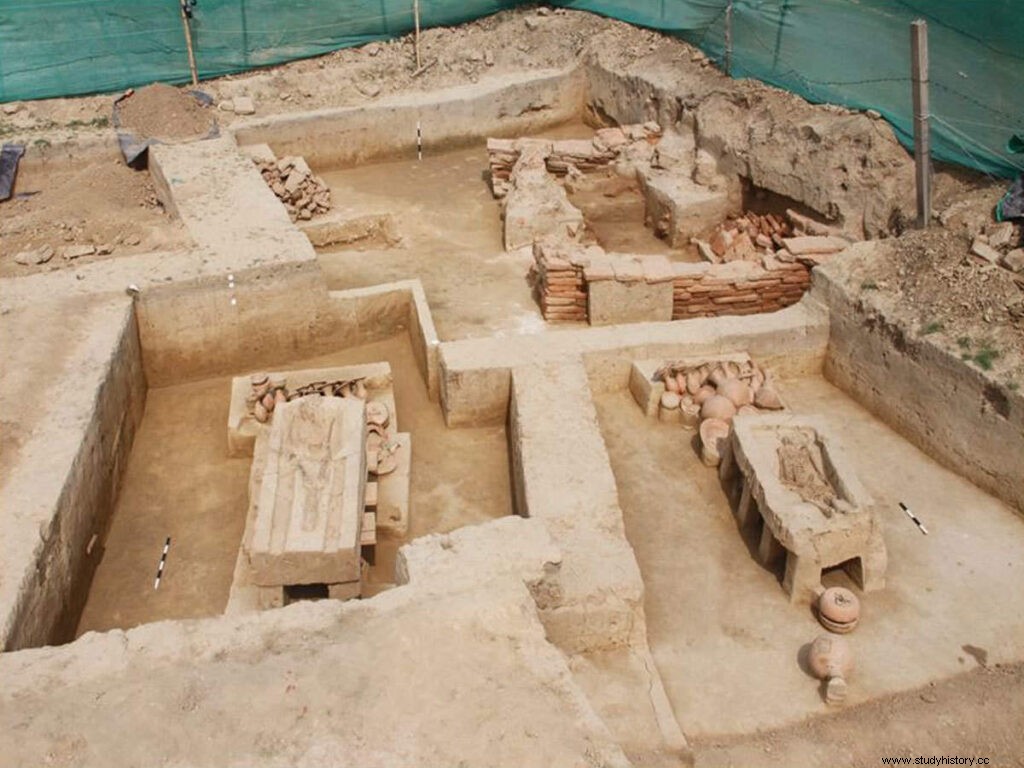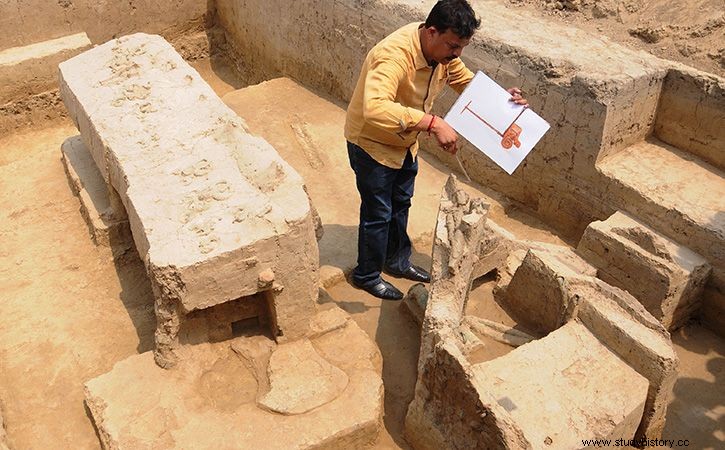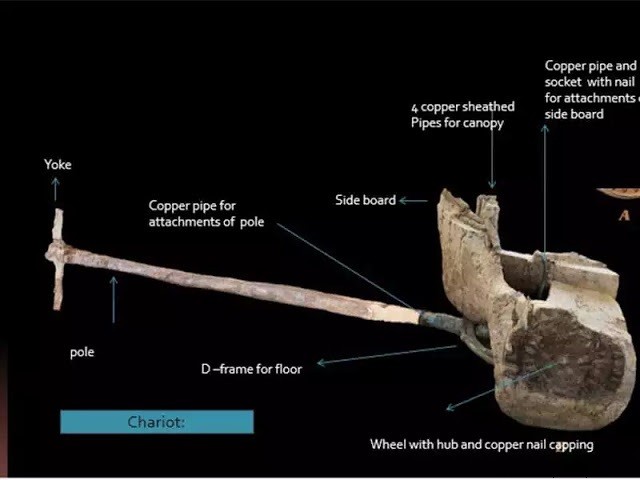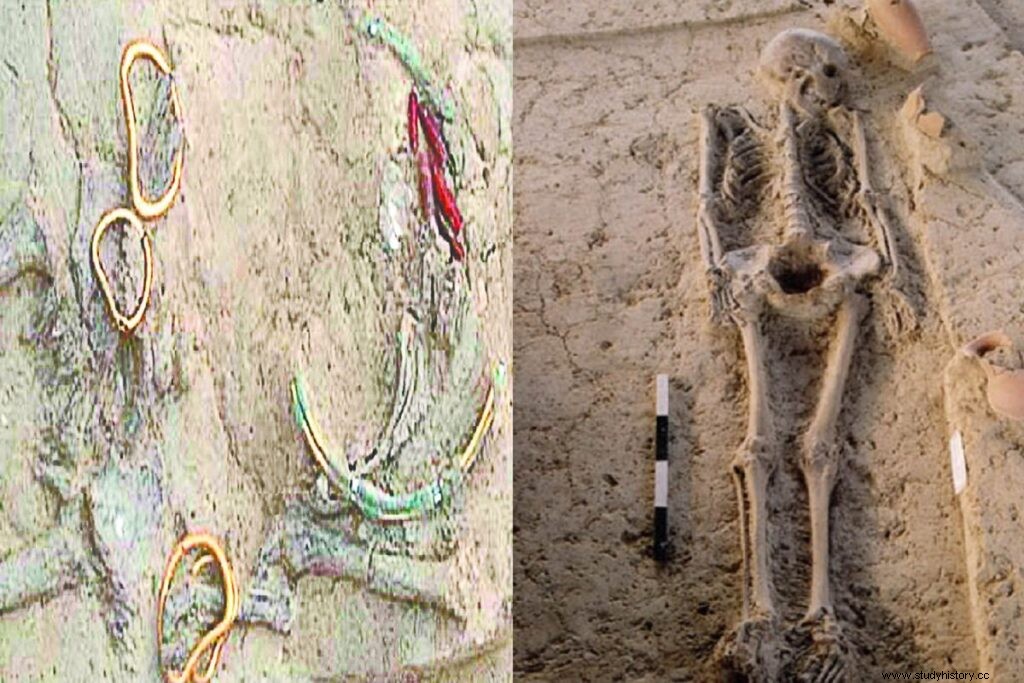The history of ancient India is buried under the village of Sinauli in Baghpat district of Uttar Pradesh. When the Archaeological Survey of India (ASI) team excavated here, male skeletons, mausoleums, copper shards, sheaths, swords, bow-arrows, gold ornaments, pottery, ruined kitchen etc. have come out from the ground. Chariots and weapons of ancient India have also been found in the excavation. The biggest feature is that the tomb of a woman wearing armor has also been found here, near which a copper antenna sword has been found. This evidence, refuting the theory of Aryan invasion in India, is now a matter of discussion among the people.
Opinion of the Archaeologists
According to archaeologists, the tomb of Sinauli is the royal mausoleum. Here the king or feudal lord and his people are buried. Kaushal Kishore Sharma, former Superintendent Archaeologist and historian of the Archaeological Survey of India, says that “In Sinauli, we found that which till now has never been found anywhere in India. The culture of Sinauli seems to be related to the culture between the later Vedic period and the Harappan civilization."
According to Sanjay Manjul, Director (Excavation) of ASI, the period of burial may be from 2000 to 1800 BCE, which is contemporary to the Late Harappan culture, but different from that of OCP/Copper hoard culture. Is. According to Manjul, “For the first time in the Indian subcontinent, chariots have been recovered from an excavation. The chariots found here are of Indo-Aryan techniques used in the war. He further noted that "the rituals related to the samadhis of Sinauli appear to be closely related to the Vedic rituals" and speculated that "the dating of the Mahabharata may be around 1750 BCE.
According to other archaeologists, the types of chariots, sword-shields and helmets (topa) used in war in Mesopotamia and other cultures around 2000 BC were also here around the same period. They were very technologically advanced and had arrived here contemporaneously or slightly earlier than other civilizations.
What was found in the excavation of Sinauli

The first excavation in this village was done in 2005. Only after this ASI excavated 106 human skeletons from here. In the second phase in 2017 and in the third phase in 2019, more than one object came out in the excavation.
In the excavations being conducted by the Archaeological Survey of India in Sinauli, information about a secret chamber has been found. This chamber was used to apply paste after the body was brought for the last rites, after which it was placed in a coffin and buried underground. Signs of entry from the south direction have been found in this chamber. Evidence has also been found of the dead bodies being wrapped and sanctified according to Hindu culture before burial. The remains of rice grains and ash have been found in the utensils found near the dead bodies.

There are mainly primary samadhis and some have been identified as secondary, multiple and symbolic samadhis which include both male and female samadhis. The samadhi usually has an odd number of pots/bowls (odd numbers are considered auspicious in Hindus) near the head, usually at the hip as well as flask-shaped utensils, terracotta figurines, gold bracelets and copper bangles. , Garlands of semi-precious stones etc. have been found. Other finds include copper helmets, copper antennae swords, copper swords, shields, a ladle made of copper, grey-ware pottery, large terracotta pots, red vases with flared rims, copper nails, beads and whips .

Description of the three major tombs

There are three coffins in the seven human samadhis, that is, the dead bodies are buried in a wooden coffin. In all the samadhis, the head is towards the north and the feet are towards the south and utensils are kept above them below. Copper items are kept under the tomb.
In the primary coffin of number one, two full-sized chariots are kept on either side, whose structure is like a horse cart, but the remains of a horse or bull have not been found there. The wooden coffin stands on four legs and the entire coffin including the legs is covered from all sides by a copper strip.

The wooden chariot has two solid wheels. The wheel rotated on a fixed axle which was attached to the yoke by a shaft. The chariots are covered with thick copper sheets. The wheels are decorated with triangles made of copper. The seat is semi-circular. The seat frame is made of copper pipe. A pipe is also visible to put an umbrella on top.
Primary coffin mausoleum 2:The third chariot is also found with another wooden coffin mausoleum. A violin-shaped shield (decorated in copper with geometric patterns), a torch, an antenna sword, a khanti, hundreds of beads and various types of utensils have also been found in the tomb. The chariot, unlike the other two, has copper triangle decorations on the pole and yoke.

The third primary coffin is the mausoleum without a copper cap. This is the skeleton of a woman wearing a armor. It is made of agate beads tied around the elbow. It has 10 red pots with flared rims, four bowls, two basins and an antenna sword.

who were these people after all?
Now let me introduce you to the process of burial practiced in the Scythians of Central Asia. You will be stunned to know that the process of burial practiced in the Shakas of Central Asia is the same as the process of burial found in Sinauli, Uttar Pradesh.
“The system of marriage was very early in the doubts. Many brothers could have one woman. Men could have more than one wife. On the death of a chieftain, one of his wives had to accompany her husband in the grave. Like the feudal lords of Egypt, even in doubt, the funeral procession was done with great pride. Along with the dead Sardar, all those things which he needed in life were kept in the grave. All kinds of weapons, jewellery, food items and horses were not only kept in the tomb, but the slaves and tens also had to accompany the master. In the old Shakas, there was a custom to bury the dead bodies of the feudatories.
Along with burying the dead, there was also a custom of burning the dead in doubt. At that time the wife needed to be burnt alive to send along, which an Arab tourist had seen with his own eyes.
Not only the fruits of arrows and spears, their axes and long straight swords were also of brass. Their women fought in the war like men, and many times they also led the army.
The skeletons of a man and a woman were found in a Pajiriq Shaka mausoleum discovered in the 1990s. Each had weapons, arrowheads and an ax. The Shaka women warriors were dressed in the same clothes as the men. (Wikipedia, Saka)
The tombs of the Shakas found in the Altai region of Soviet Russia have been described by Russian archaeologists as follows:
The body box made of strong cedar was so heavy that it was impossible to take it out without disassembling it. First the tightly fitted upper lid was removed… their number was two – one the body of a Saka soldier and the other by his wife. According to ancient custom, even the best things in the house were buried with the dead person….
From the excavations done so far, archaeologists have come to know that they will find horses behind the wall of the tomb. In fact, he saw a wooden wall, behind which fourteen beautiful horses were buried. All of them were safe with their luxurious furnishings. The gins decorated with wood carvings and gold letters, horse cloaks in various colours, and oars made of silk were all very beautiful.
It is clear from the above that the process of burial and cremation found in Sinauli village of Baghpat is similar to those found in Central Asia and Altai of Soviet Russia. Only one big difference is visible and that is that in the tombs of those Shakas, their horses were also buried along with the Shaka feudatories, kings, whereas in Sinauli three chariots have been found but the remains of the horse have not been found. It seems that since the Sakas of Central Asia were backward in the level of development even after AD and preferred to lead a nomadic life, they mostly rode horses or not chariots. That's why their horses were buried with their dead bodies. But Indian civilization was still at the highest peak of development at that time. Here chariots were used on a wide scale, so here the chariots on which they stood were buried together, not the horses with the dead bodies.
But this does not mean that it must have been done for the purpose of not killing unnecessary animals on human grounds, because like in Central Asia, the dead bodies of kings or feudal lords are buried with their slaves, which are seen in 98 simple tombs. Which includes women, men and even children.
Similarity between Mahabharata era culture and Shaka culture of India
This question used to arise in my mind that why Emperor Yudhishthira has been called "Saka" somewhere in Mahabharata. The answer to this question is found during the study of the culture of the Shakas. Pay attention to these cultures of doubts below.
“In the marriage system of the Shakas, many brothers could have one woman. The children of that woman were considered to be the children of the eldest brother. Men could have more than one marriage. (History of Civilizations of Central Asia. Paris:UNESCO Publishing. pp. 138–165)
On the death of a chieftain, one of his wives must have supported her husband in the grave. Along with burying the dead, there was also a custom of burning the dead in doubt. At that time there was a need to burn alive to send the wife along. Their women fought in the war like men, and many times they also led the army.
Chinese and Greek writers agree that the main food of the Shakas was meat and the main paan was milk. They used to drink the hot blood of the first fallen enemy in battle."

Now look in Mahabharata. The five Pandavas had a joint wife, Draupadi. Some brothers also had different wives. On the death of Pandava's father Maharaj Pandu, Maharani Kunti, being an elder, proposed to be sati, but later on the request of his younger wife Madri, Madri became sati with the funeral pyre of Maharaj Pandu. Madri, the princess of the country of Madra and the wife of Maharaja Pandu, was well versed in warfare. Everyone knows that Mahabali Bhima was drinking the blood of Dushasan's chest in the Mahabharata war.
I have only found this similarity. It is possible that the character of Maharaja Yudhishthira has some other characteristics related to the culture of the Shakas, due to which he has been called Yudhishthira Saka many times. By the way, Shalivahana Saka has also been used for Shalivahana, the grandson of Chakravarti Emperor Vikramaditya.
Many methods of funeral ceremony were in vogue in Rigvedic period and Vedic period India, which you can understand by reading on the page given below:

It is clear from the above that the culture was similar to the Indian culture. That is why Rahul Sankrityayan, who writes the history of Central Asia, says, "No matter how much the difference between the Shakas and the Aryans, but if we consider the vast Indo-Aryan dynasty, then that distinction seems negligible. The migration of Indo-Europeans from Central Asia to Europe is accepted by all and it is believed that this happened in the Neolithic period."
It is clear that the culture of the doubts of Central Asia was similar to Indian culture. The question is, were the Sakas of Central Asia ever a resident of India? After all, who were these suspicious people?
Read the link below to read the ancient Indian history of the Shakas mentioned in Indian texts and their verification from modern global historical and archaeological research.
